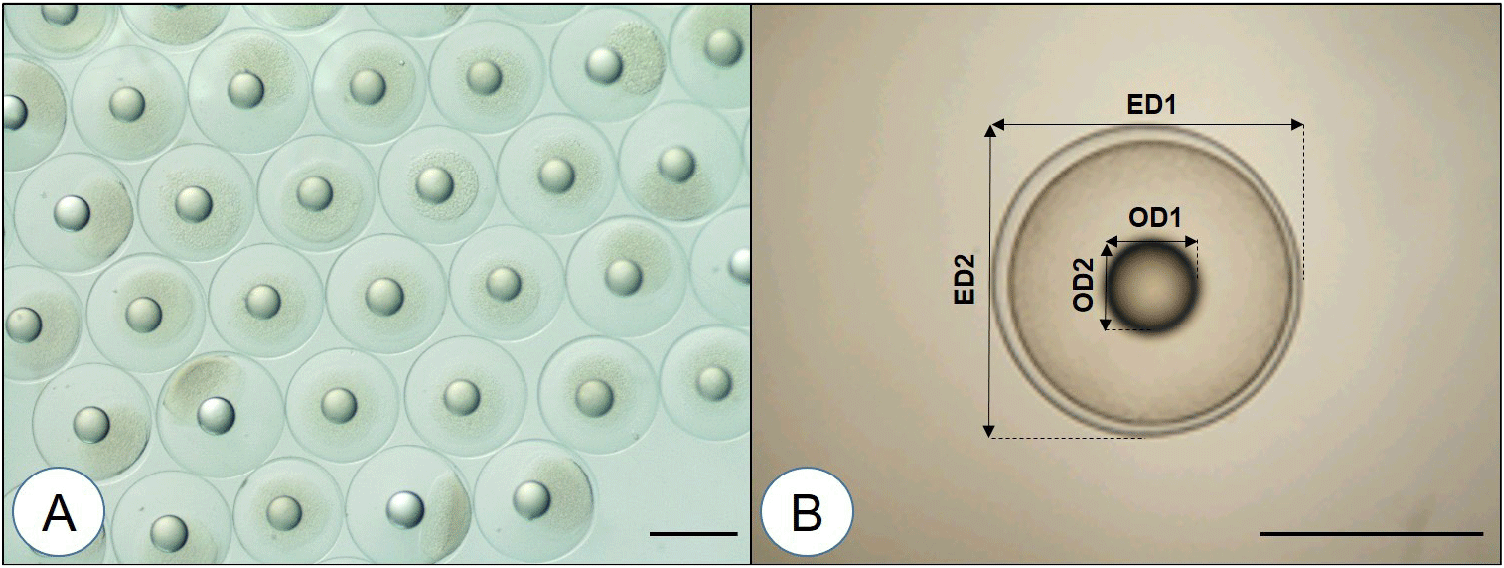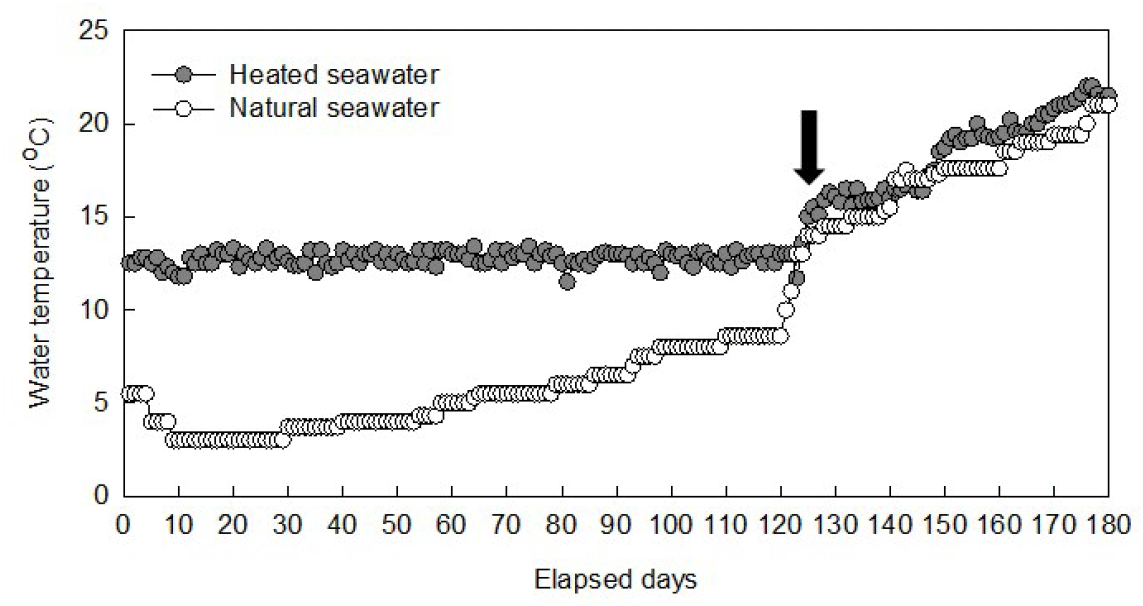INTRODUCTION
Egg quality would be defined as the condition of the eggs that have a profound effect on fertilization success, hatching success, larval growth and survival (Carter et al., 2015). Egg quality in fishes is closely related to mass mortality during early broodstock rearing, and in species that spawn multiple times with separated hatchlings, and also largely influenced by maternal nutritional status, age, husbandary practices and degree of domestication (Krejszeff et al., 2009; Migaud et al., 2013; Bobe, 2015). Previous studies reported that indicators to evaluate egg quality include egg shape, hatchability, biochemical composition and molecular mechanism (Migaud et al., 2013; Stuart et al., 2020). However, these are not used easily in fish farming site and the evaluation methods would be simple and applied early on development (Stuart et al., 2020).
Small yellow croaker belongs to the Order Perciformes (Family Sciaenidae) and it is high commercial value species in Korea (NFRDI, 2011). Research on aquaculture for this species has included studies on embryo development and juvenile breeding, seed production technology and effects of rearing condition on male maturation (Myoung et al., 2004; Kim et al., 2021). Recently, artificial seed production has been become possible and is being cultivated commercially in southern regions of Korea, Jeollanam-do and Jeju Island using net cage and indoor tank. The aim of this study was to evaluate egg quality indicators for easily measurable parameters in the fertilized eggs from second generation of cultured small yellow croaker for expansion of the aquaculture industry.
MATERIALS AND METHODS
The cultured second-generation broodstock were artificially produced from wild broodstock caught off the coast of Younggwang, Jeollanam-do, Korea and reared. The second-generation broodstock used in this study were 3-year-old individuals. Broodstock rearing was conducted using circular concrete tanks (30 tons), holding 600 fish. The supplied feed was extruded pellet with frozen shrimp (10% of total supplied feed). The water temperature was regulated from 11.5°C to 22.0°C with heater and the photoperiod was regulated as 9L:15D with the illuminance of 100 lux or less. Salinity was maintained 30.0–32.0 psu and dissolved oxygen was kept above 7.0 mg/L.
To collect fertilized eggs, a collecting net (φ 60×H 45 cm, mesh size 700 μm) was placed and the eggs discharged through the central drainage pipe. Fertilized egg trap was checked daily at 9:00 am. The fertilized eggs were washed several times with filtered seawater and placed in a 2 L beaker with a large surface area to separate the floating and sunken eggs, and only the floating eggs were selected to calculate the viability.
A picture of survived eggs was taken from each spawning event (Image Pro Plus; BX-50, Olympus, Tokyo, Japan), from which egg and oil droplet diameters (ODs) were randomly measured from 50 eggs. For each spawning event, the following egg measures were recorded; viability (%; defined as survived eggs from the total spawned eggs), egg diameter (ED, ±0.01 mm), OD (±0.01 mm) and the ratio of ED/OD was calculated. The egg and oil droplet (a single oil droplet) were assumed to be spherical, and volumes were calculated from single measurements of diameter according to the formula (i.e., V=4/3πr3). The shapes of eggs and oil droplet were also calculated as shape coefficient of egg (SCE) and shape coefficient of oil droplet (SCO) according to the methods by Çoban et al. (2011).
A Pearson’s correlation coefficients were calculated and were determined trends between the morphometrics and egg viability. Correlations were determined significantly at p<0.05.
RESULTS AND DISCUSSION
Broodstocks were reared with heated seawater from 11.5°C–13.6°C during winter period (January to April). At 126th day, first spawning was observed and spawning was carried on from 7 to 30 May (until 150th day). The water temperature ranged from 15.1°C to 22.0°C through the spawning period (Fig. 2). Significant linear relationships between ED (y=−6.4493x+1,446.4989, R2=0.80) and water temperature (y=−0.0887x+15.4656, R2=0.56) were founded with consecutive date during spawning period (Fig. 3). Previous studies reported that the ED of multiple spawning species such as haddock and California yellowtail decreased during spawning period (Rideout et al., 2005; Quiñones-Arreola et al., 2015; Stuart et al., 2020). In Atlantic haddock, the energy for oocyte maturation and is dramatically less than at the beginning of the spawning as the water temperature increases, that could produce smaller eggs (Trippel & Neil, 2004). In the present study, ED decreased 18% during the spawning period. Further study with biochemical composition of the eggs over the course of the spawning period would provide more information for changes in ED.



In the relationship between egg viability and morphometrics, the viability was higher in smaller ED, OD, egg volume and oil droplet volume than those of larger them (Fig. 4). Among the four morphometrics, OD, egg volume and oil droplet volume indicated significant negative relationship with viability (p<0.05). Meanwhile, the viability was higher in high ratio of ED/OD, SCE and SCO (Fig. 5). Among these three morphometrics, only the ratio of ED/OD indicated significant positive relationship with viability (p<0.05). These results suggest that OD was more potent indicator for prediction of egg quality rather than ED and the smaller ED or OD would represent higher egg viability in small yellow croaker.


Similar results were also reported that larger ED does not represent higher egg quality in turbot (Forés et al., 1990) and the OD were smaller in high quality eggs with higher embryonic survival and hatching success than those of in poor quality eggs of European eel (da Silva et al., 2018). In addition, eggs with various size could demonstrate similar developmental characteristics in trout and sea bass (Bromage et al., 1992; Cerdá et al., 1994). In contrast to the present study, previous studies reported that larger eggs would indicate higher egg viability or survival in pejereey, Atlantic cod and California yellowtail (Chalde et al., 2014; Petersen et al., 2016; Stuart et al., 2020). These studies implied that larger eggs may have more yolk components and leads to hatched larvae with more amount of reserves.
In the relationship between SCE or SCO and viability, the viability increased as SCE and SCO increased. SCE and SCO with lower value converge to a spherical shape while their higher value converges to an ellipsoidal shape (Çoban et al., 2011). These results suggest that ellipsoidal eggs from later spawning period would indicate higher viability than spherical eggs from earlier spawning period although there was no significant difference. The reason for these results are not clear yet. As reported in previous studies, the shape of eggs or oil droplet would be fluctuated by lipid composition and transition in eggs and may affect its viability (Navas et al., 1997; Rodriguez et al., 1998).
The eggs of cultured marine fish species have several merits such as small size and transparent body and therefore it is suitable for egg quality assessment using morphological parameters (Çoban et al., 2011). However, the egg quality of fish may be fluctuated by environmental conditions, mating or spawning, maternal stress, even the level of domestication and the size of egg does not always represent its quality (Bobe & Labbé, 2010; Migaud et al., 2013; Valdebenito et al., 2015; Ljubobratović et al., 2022). In this sense, the reliable factors for predicting egg quality are not known yet (Migaud et al., 2013). As mentioned above, we demonstrated OD was more potent indicator for prediction of egg quality rather than ED in second generation of small yellow croaker. The morphometric parameters and distribution of oil droplet were also suggested as indicator for egg quality in brown trout and common dentex (Mansour et al., 2007; Çoban et al., 2011). The function of oil droplet during early egg development is not clearly understood, but it has been proposed that the main metabolic fuel after hatching and maintenance for buoyancy in the water (Chen & Yapa, 2007; Chalde et al., 2014). Further study such as the transition of oil droplet to yolk, embryonic developmental characteristics and hatching success would provide more information about predicting of egg quality for small yellow croaker.
In conclusion, the present study demonstrated that smaller eggs of small yellow croaker indicated higher viability with negative relationship between smaller OD, egg volume and oil droplet volume. Moreover, viability also indicated positive relationship with the ratio of ED/OD. Particularly, these methods enough to easy to apply in fish farming site and require less time than that of complicated analysis.

